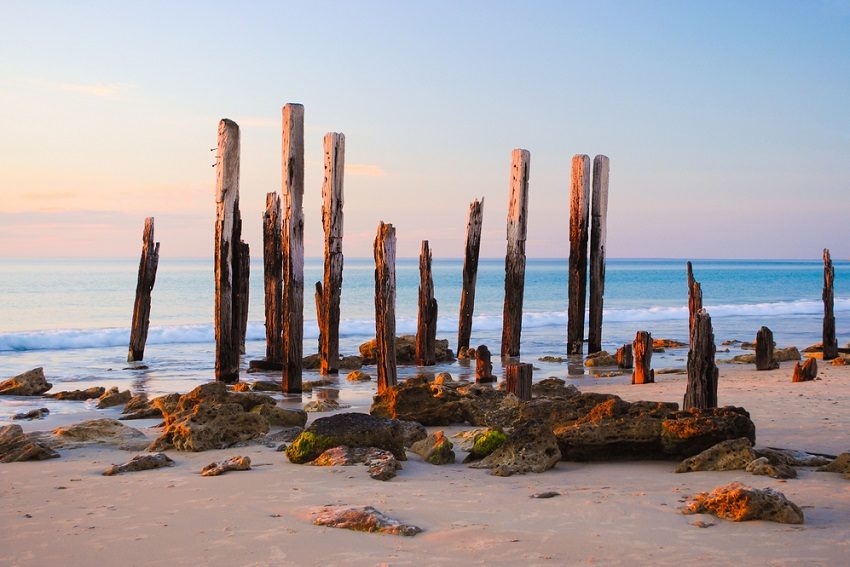Good Country: Why are there two Willungas?

It’s a confounding question. Why do two southern SA towns have the same name? Michael X Savvas investigates the Willungae mystery, finding a unique industrial history at its centre.
I never got why two southern SA locations, Willunga and Port Willunga (known collectively as the Willungae) have almost identical names. I mean, it’s not like they’re neighbours: one’s coastal and one’s inland, and they’re separated by a 10-minute drive.
My confusion doesn’t end there.
I know that Port Willunga is the popular holiday suburb with iconic old jetty remnants, iconic caves in imposing umber cliffs and the iconic Star of Greece restaurant. Yet I’ve often pondered that the iconic Star of Greece should be a Greek restaurant. But it’s not. It was named after the Star of Greece ship, tragically shipwrecked within cooee of the Port Willunga shore in 1888. The ship was also not Greek; she was built in Ireland. Perhaps it’s my Greek/Irish heritage, but this part makes sense.
I thought I’d discovered the elusive connection between Port Willunga and the town of Willunga: shapeshifting. Willunga’s very pleasant Golden Fleece Cafe also seems to refer to a star of Greece, the golden fleece of ancient Greek mythology. In fact, the café has a Golden Fleece service station theme. Yet it was built on the site of a former service station, which wasn’t actually a Golden Fleece. It was a Shell. But the owner was named Goldie.

Sipping a cappuccino with my partner, I sit back and take in the café’s funky retro ambience. A pair of old-school roller skates nestling alongside a poetry anthology of Aussie bush poet Adam Lindsay Gordon both reveal good taste. Wiping the chocolate from my nose, I bask in smug satisfaction from solving what both Willungae towns have in common: places with deceptive names.
It was not until visiting Willunga’s old courthouse and slate museum that I realised how wrong I was.
I now know that slate is the answer (to everything). The elegant and artistic Willunga began in 1839 as three huts for police, surveyors and postal workers. But in 1840, with the discovery of slate, the town became something very different. Four quarries were opened, and slate became a significant source of income for both Willunga and SA. The slate museum (unique in Australia) and its helpful, informative guides explained well the economic, cultural and practical history of Willunga slate. This includes the reason why Port Willunga was actually established in the 1850s: as a port to ship Willunga slate and produce to Adelaide and interstate. It was like another campus of Willunga.

Call it confirmation bias, but after learning of the slate, I started to see it everywhere in the town. It’s used as roof tiles on some houses and buildings and as posts in some front-yard fences. Even the sign welcoming visitors to Willunga is on slate.
Glenn Howlett, talented glassblower and owner of Willunga Glass Studio, waxes lyrical about the skill involved in cutting and fitting slate for the old rainwater tanks, which were made of slate and didn’t leak. Howlett also points out that slate was used in the gutters that still line either side of Old Willunga Hill Rd. He recalls an old farmer telling him that these gutters were made during World War II with the aid of German internees.
Ailie Beck exhibits her artwork at the Willunga Glass Studio. Apart from her lovely, exquisitely detailed sculptures of native birds and animals, she paints on slate “canvases”. She says, “I do like the feel of painting slate.” Beck even wears slate earrings that she’s made.

Willunga grape grower and businessman Geoff Hayter, who’s using slate in the house he’s building, also appreciates Willunga slate’s qualities. “You get some slate that’s really rippled on the surface. You can see the seabed in it.”
Hayter regales me with tales of a “wiry slate wrangler” who used to ride down the local quarry hills like a cowboy … on a piece of slate. Hayter adds, “Willunga is a beautiful landscape and a fantastic community.” He then stops and looks at me with narrowed eyes. “Do you have a special interest in slate?”
Before visiting the Willungae, my answer would have been no. Now, I’m right into it. I’m seriously considering changing my name by deed poll to Michael Slater.